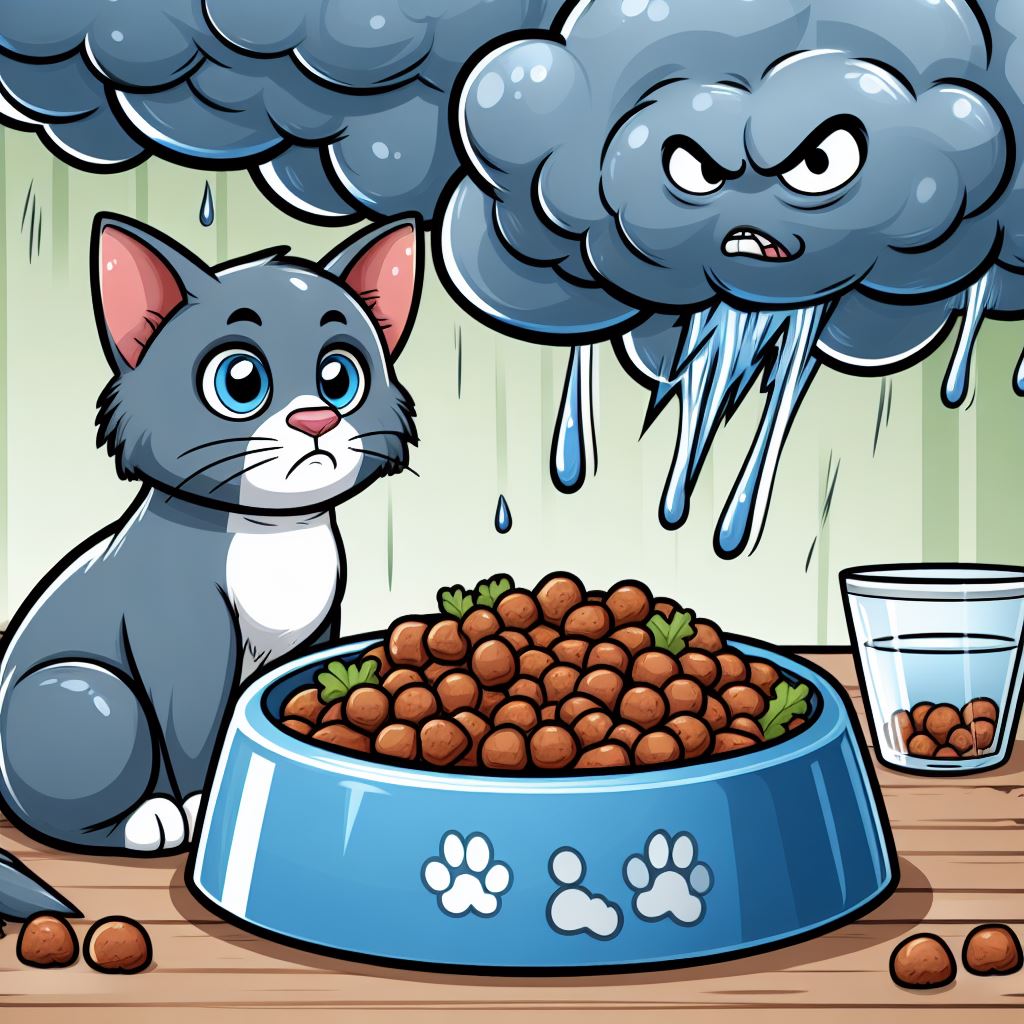Your cart is currently empty!

Irreconcilable Differences: Permanent Breakup with Dry Cat Food
My relationship with dry cat food began less like a dreamy, passionate romance and more like a marriage of convenience arranged by an ill-intentioned dimwit. Everything I knew about feeding cats, which wasn’t much, came from imitating what others were doing. Or from complacency knowing my veterinarian raised no objections. After all, there’s comfort doing things like pretty much everyone else is. And when a veterinarian approves – or at least doesn’t object? No reason to leave that marriage. Plus, at first glance, there seemed to be so much to commend dry food. Why waste money on food that’s got a bunch of water filler? And the convenience can’t be beat. Fill up the bowl when it’s empty and be done. Then there are those reassuring, if somewhat indecipherable and misleading, labels. Meets AAFCO minimums! Veterinarian recommended! It wasn’t until I was decades in to life with cats that I came to see that marriage of convenience was not doing my cats any favors. And, in fact, was likely compromising their health. When a young orange cat named Duke came into my life, with time I finally figured out that his nonstop battle with digestive woes might have something to do with what I was putting into his digestive system. At the time, none of the vets I worked with suggested that the ultraprocessed meat-flavored cereal I was feeding him might be the problem. In fact, the one nutritional suggestion I had from a vet was to feed him a ‘prescription’ form of ultraprocessed meat-flavored cereal. Relationship Hits the Rocks: “We Have to Talk” I was reluctant to give up the convenience of dry food, but when the ‘prescription’ food did nothing to improve Duke’s diarrhea and overall gastrointestinal unhappiness, I started digging around online. As I started to look into the science around cats, learning that these creatures are nature’s obligate carnivores, it became harder to reconcile what common sense dictated about what they should eat with the ingredient lists on even the so-called best dry food. “It Isn’t Me, It’s You” We were still in the era of online e-groups (before things like Facebook were part of daily online life) and stumbled on one focused on feline IBD, run by a marvelous woman in Canada named Lee Ellis. Over the coming months, Lee and I bonded over our cats with digestive woes and one day she posted that her cat had a “miraculous” turnaround when she began feeding home-prepared raw food. On the one hand, that sounded like utter madness to me. And on the other, the idea of a diet that mimicked a cat’s natural prey aligned a whole lot better with what I’d learned about what helps these carnivores thrive. I started with a trial separation from dry food which went nowhere. I hoped there was a compromise where I could still enjoy the convenience of feeding dry food, but like any toxic relationship, the best solution is to get on outta there. Finding Love Again I trusted Lee. And by then I’d been lucky enough to run into a couple of early trailblazers in the education of us cat people about how to safely prepare and serve a balanced diet I made in my kitchen. It was also about the time that my friendship with Dr. Lisa Pierson took, and when Duke’s symptoms disappeared, literally overnight (never to return) once I had tossed dry food out of our lives in favor of species-appropriate homemade raw food, I filed for a quick divorce from dry food. In the decades since my breakup with dry food, my eyes have been opened to even more reasons that my relationship with dry food was never going to take me or my cats anywhere we wanted to be. I learned that the moisture that’s missing from dry food is not empty filler, but an essential nutrient that supports many vital functions in cats. Dry food creates conditions for an insufficiently flushed urinary tract, kidneys that can’t keep up with the need to filter impurities, and compromised digestion. Just for starters. I learned that dry food is a culprit contributing to feline obesity. Reducing or eliminating carbohydrates – a good idea for any carnivore, overweight or not – is absolutely essential for safe and lasting weight loss. There’s no way to safely reduce an obese cat’s weight using a dry food-based diet. I learned that the invariably high carbohydrate content of dry food contributes to feline diabetes. It messes with the glucose balance and insulin response of cats putting pre-diabetic and diabetic patients in a terrible state of health. As with any relationship, we learn from our mistakes, and I like to think that my ongoing lay person education in the cat nutrition world has taught me to never get too cocky about what I think I know. I’ve made adjustments to the diet I feed my cats over time as new information comes on to my radar screen. And I’m also more keenly aware than ever before that every cat is different: the diet formulation that’s right for.a healthy young adult cat is going to be different for a senior cat with compromised kidney function, for example. I’ve learned the value of humility. We have still not fully deciphered Mother Nature. Those of us who feed homemade food to cats using ingredients and sources from something other than what a small cat would kill and eat on her own are wise to never assume we have Mother Nature all figured out. I have plenty to yet to learn, but I have no doubts that my breakup with dry food was the right thing.
Leave a Reply